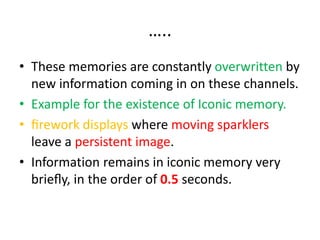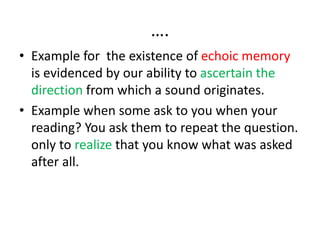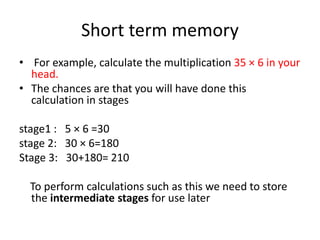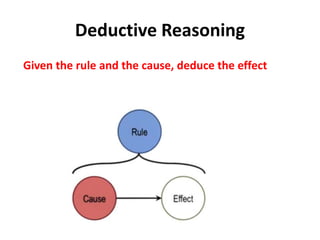Human computer interaction-Memory, Reasoning and Problem solving
- 1. CS8079-Human Computer Interaction Presented by N. Jagadish kumar Assistant Professor Department of Information Technology Velammal Institute of technology
- 2. Unit-1 Foundation of HCI Session-3 • The Human – Memory – Reasoning & Problem solving
- 3. Definition • Memory is our ability to encode, store, retain and subsequently recall information and past experiences in the human brain. • It can be thought of in general terms as the use of past experience to affect or influence current behavior.
- 4. Structure of memory • Much of our day-to-day activities rely on memory. • Apart from storing information, it contains our knowledge of actions or procedures.
- 5. …. It is generally agreed that there are three types of memory or memory function: • sensory buffers • short-term memory or working memory • long-term memory These memories interact, with information being processed and passed between memory stores.
- 6. Sensory Memory • The sensory memories act as buffers for stimuli received through the senses. • A sensory memory exists for each sensory channel: • iconic memory for visual stimuli • echoic memory for aural stimuli • haptic memory for touch
- 7. ….. • These memories are constantly overwritten by new information coming in on these channels. • Example for the existence of Iconic memory. • firework displays where moving sparklers leave a persistent image. • Information remains in iconic memory very briefly, in the order of 0.5 seconds.
- 8. …. • Example for the existence of echoic memory is evidenced by our ability to ascertain the direction from which a sound originates. • Example when some ask to you when your reading? You ask them to repeat the question. only to realize that you know what was asked after all.
- 9. …. • Information is passed from sensory memory to short-term memory by attention, thereby filtering the stimuli to only those which are of interest at a given time. • Attention is the concentration of the mind on one out of a number of competing stimuli or thoughts.
- 10. Short term memory • For example, calculate the multiplication 35 × 6 in your head. • The chances are that you will have done this calculation in stages stage1 : 5 × 6 =30 stage 2: 30 × 6=180 Stage 3: 30+180= 210 To perform calculations such as this we need to store the intermediate stages for use later
- 11. …. • Short-term memory can be accessed rapidly, in the order of 70 ms. • However information can only be held there temporarily, in the order of 200 ms.
- 12. … • There are two basic methods for measuring memory capacity. • The first involves determining the length of a sequence which can be remembered in order. • The second allows items to be freely recalled in any order.
- 13. …. • Look at the following number sequence: 265397620853 • Now write down as much of the sequence as you can remember. • How many digits could you remember? If you remembered between five and nine digits your digit span is average.
- 14. … • Now try the following sequence: 44 113 245 8920 • Here the digits are grouped or chunked. Therefore chunking information can increase the short-term memory capacity. • The successful formation of a chunk is known as closure • This process can be generalized to account for the desire to complete or close tasks held in short-term memory…….
- 16. Experiment to recall Sequence of words • Most people would have difficulty remembering the following sequence of chunks: • HEC ATR ANU PTH ETR EET • However, if you notice that by moving the last character to the first position, you get the statement ‘the cat ran up the tree’ the sequence is easy to recall.
- 17. .. • In experiments where subjects were able to recall words freely, evidence shows that recall of the last words presented is better than recall of those in the middle . This is known as the recency effect.
- 18. Long Term Memory • long-term memory is our main resource. • Here we store factual information, experiential knowledge, procedural rules of behavior – in fact, everything that we ‘know’. • First, it has a huge, unlimited, capacity of memory. • Secondly, it has a relatively slow access time from the memory. • Thirdly, forgetting occurs more slowly in long- term memory
- 19. …. • Long-term memory is intended for the long- term storage of information. • long-term recall after minutes is the same as that after hours or days.
- 20. Long Term Memory Structure • There are two types of long-term memory: 1.episodic memory 2. semantic memory.
- 21. Episodic memory • Episodic memory : involves the recollection of specific events, situations, and experiences. Your memories of • your first day of school • attending a friend's birthday party • your brother's graduation are all examples of episodic memories.
- 22. Semantic memory • Semantic memory refers to general world knowledge that we have accumulated throughout our lives. • For example, knowing that football is a sport is an example of semantic memory
- 23. our knowledge about dogs may be stored in a network Semantic networks represent the associations and relationships between single items in memory
- 26. …. • Structured representations such as frames and scripts organize information into data structures. • Slots in these structures allow attribute values to be added. • Frame slots may contain default, fixed or variable information. • Frames and scripts can be linked together in networks to represent hierarchical structured knowledge.
- 27. … • A script comprises a number of elements, which, like slots, can be filled with appropriate information: • Entry conditions Conditions that must be satisfied for the script to be activated. • Result Conditions that will be true after the script is terminated. • Props Objects involved in the events described in the script. • Roles Actions performed by particular participants. • Scenes The sequences of events that occur. • Tracks A variation on the general pattern representing an alternative scenario
- 28. Frames
- 29. Exercise • Complete the frame representation of the figure below:
- 30. Exercise • Complete the frame representation of the figure below:
- 31. Long Term memory process • There are three main activities related to long- term memory: 1.storage or remembering of information 2.forgetting 3 information retrieval
- 32. …. • Information from short-term memory is stored in long-term memory by rehearsal. • The repeated exposure to a stimulus or the rehearsal of a piece of information transfers it into long-term memory.
- 33. … • This process can be optimized in no of ways. • Total time hypothesis – According to Ebbinghaus. He discovered that the amount learned was directly proportional to the amount of time spent learning. • Distribution of practice effect- According to Baddeley . learning time is most effective if it is distributed over time. • Example: training period was divided into weekly sessions of one hour performed better than those who spent two or four hours a week learning
- 34. Long-term memory processes • Theories of Forgetting – Decay – Interference • Decay:The first theory suggests that the information held in long-term memory may eventually be forgotten. • Jost’s law, which follows from this, states that if two memory traces are equally strong at a given time the older one will be more durable. • Interference: The second theory is that information is lost from memory through interference.
- 35. Long-term memory processes Retroactive interference • If we acquire new information it causes the loss of old information. • Example : If you change telephone numbers, learning your new number makes it more difficult to remember your old number. This is because the new association masks the old. Proactive Inhibition • Sometimes the old memory trace breaks through and interferes with new information. • Example : When you find yourself driving to your old house rather than your new one.
- 36. Information Retrieval • Two types – Recall – Recognition • Recall: the information is reproduced from memory. – Recall can be assisted by the provision of retrieval cues, which enable the subject quickly to access the information in memory. – One such cue is the use of categories. • Recognition: the presentation of the information provides the knowledge that the information has been seen before. – Recognition is the less complex cognitive activity since the information is provided as a cue.
- 38. So far we discussed about how information finds its way into and out of the human system and how it is stored.
- 39. THINKING: REASONING AND PROBLEM SOLVING • Finally here we come to look at how it is processed and manipulated. • This is perhaps the area which is most complex and which separates humans from other information-processing systems, both artificial and natural.
- 40. … • Animals can receive and store information. • Artificial intelligence machines can receive and store information. • But their ability to use that information is limited when compares to human. • Humans have the ability to use the information they stored for reasoning & Problem solving
- 41. Humans solve problems which we have never seen before. able to think about things of which we have no experience Conscious and Self- aware Able to use information to reason and solve problems 04 03 02 01
- 42. Reasoning • Reasoning is the process by which we use the knowledge we have to draw conclusions or infer something new about the domain of interest. • There are a number of different types of reasoning: • Deductive • inductive • abductive.
- 43. Inductive Reasoning • Induction is generalizing from cases we have seen to infer information about cases we have not seen. Example 1: The coin I pulled from the bag is a penny. That coin is a penny. A third coin from the bag is a penny. Therefore, all the coins in the bag are pennies. Example 2: conclusion does not follow logically from the statements. Harold is a grandfather. Harold is bald. Therefore, all grandfathers are bald
- 44. Inductive Reasoning Given a cause and an effect, induce a rule. Example : You can induce that the soup is tasty if you observe all of your friends consuming it.
- 45. Inductive Reasoning Check whether the mangoes are ripe or raw?
- 52. Deductive Reasoning Given the rule and the cause, deduce the effect
- 53. Deductive Reasoning Deductive reasoning derives the logically necessary conclusion from the given premises. Example 1 – Derive logically necessary conclusions If it is Friday then she will go to work It is Friday Therefore she will go to work. Example 2 – Not necessarily be True If it is raining then the ground is dry It is raining Therefore the ground is dry.
- 54. Deductive Reasoning • Often misapplied… Some people are babies Some babies cry >> Some people cry?? Invalid deduction, Not told that all babies are people. Truth and validity clash. People bring their world knowledge into the reasoning process
- 55. Abductive Reasoning Given a rule and an effect, abduce a cause.
- 56. Abductive Reasoning • Given a rule and an effect, abduce a cause • It begins with an incomplete set of observations and proceeds to the likeliest possible explanation for the set. • Abductive reasoning yields the kind of daily decision- making that does its best with the information at hand, which often is incomplete. • A medical diagnosis is an application of abductive reasoning: given this set of symptoms, what is the diagnosis that would best explain most of them? • Examples of abductive reasoning include – A doctor making a diagnosis based on test results – A jury using evidence to pass judgment on a case: in both scenarios, there is not a 100% guarantee of correctness—just the best guess based on the available evidence.
- 57. Problem Solving • If reasoning is a means of inferring new information from what is already known, problem solving is the process of finding a solution to an unfamiliar task, using the knowledge we have. • Human problem solving is characterized by the ability to adapt the information we have to deal with new situations. However, often solutions seem to be original and creative.
- 58. …. 1 • Gestalt View 2 • Problem Space Theory 3 •Analogy in Problem Solving
- 59. Gestalt Theory • Problem Solving is both productive and reproductive • Reproductive draws on previous experience • Productive involves insight and restructuring of the problem • Not provide sufficient evidence or structure to support its theories • ‘Functional Fixedness’ is a Gestalt term referring to and when learning or past experience impedes problem solving
- 60. Gestalt Theory
- 61. Maier’s Pendulum Problem • Birch and Rabinowitz (1951) adapted the two-cord problem from Maier (1930, 1931), where subjects would be given 2 cords hanging from the ceiling, and 2 heavy objects in the room. • They are told they must connect the cords, but they are just far enough apart that one cannot reach the other easily. The solution was to tie one of the heavy objects to a cord and be a weight, and swing the cord as a pendulum, catch the rope as it swings while holding on to the other rope, and then tie them together. The participants are split into 3 groups: • Group R, which completes a pretask of completing an electrical circuit by using a relay • Group S, which completes the circuit with a switch • Group C which is the control group given no pretest experience. Group R participants were more likely to use the switch as the weight, and Group S were more likely to use the relay. Both groups did so because they were previous experience led them to use the objects a certain way, and functional fixedness did not allow them to see the objects as being used for another purpose.
- 62. Insight : Problem solving in monkeys • Monkeys showed “insight” during problem-solving. • Demonstrated productive “new way of structuring elements showing insight and creativity” • Deep useful understanding of the nature of the problem versus trial-and-error (a.k.a., reproductive // tried and true // rule-based) problem solving (e.g., of the cat-in-the-box of Thorndike, 1898). • Solved problems by using tools. • Sultan stacks boxes to reach bananas.
- 63. Problem Space Theory • Generating problem states(initial, goal) using legal state transition. • In means–ends analysis the initial state is compared with the goal state and an operator chosen to reduce the difference between the two. • Experience allows us to solve problems more easily since we can structure the problem space appropriately and choose operators efficiently. • In General Problem Solver model the problems may be unfamiliar but the knowledge that is required to solve them is present in the statement of the problem and the expected solution is clear. (Solving Puzzles)
- 64. Problem Space Theory • Moving from start state to end state by moving one disk at a time, and never placing a smaller disk on a larger disk • Goal State (clear) • Initial State (clear) • Sub-goals (problem can be broken down) • Problem Space (all possible legal moves [operators])
- 65. Problem Space Theory • all possible legal moves • Each legal move from the initial state to some intermediate state is specifically defined by an OPERATOR.
- 66. Problem Space Theory • Goal State, Initial State, Sub-goals, Problem Space • All possible legal moves (operator actions)
- 67. Analogical Mapping • One special kind of restructuring, is analogical problem solving. • To find a solution to one problem - the so called target problem, an analogous solution to another problem - the source problem, is presented. As a doctor you have to treat a patient with a malignant, inoperable tumor, buried deep inside the body. There exists a special kind of ray, which is perfectly harmless at a low intensity, but at the sufficient high intensity is able to destroy the tumor - as well as the healthy tissue on his way to it. What can be done to avoid the latter? • Mapping knowledge relating to a similar known domain to the new problem • People often miss analogous information, unless it is semantically close to the problem domain
- 68. Analogical Mapping • A General wanted to capture his enemy's fortress. He gathered a large army to launch a full-scale direct attack, but then learned, that all the roads leading directly towards the fortress were blocked by mines. These roadblocks were designed in such a way, that it was possible for small groups of the fortress-owner's men to pass them safely, but every large group of men would initially set them off. • The General divided his troops into several smaller groups and made each of them march down a different road, timed in such a way, that the entire army would reunite exactly when reaching the fortress and could hit with full strength.
- 69. Skill Acquisition • All of the problem solving that we have considered so far has concentrated on handling unfamiliar problems. • Gain insight into how skilled behavior works, and how skills are acquired, by considering the difference between novice and expert behavior in given domains.
- 70. Skill Acquisition • Backwards Chaining (working backwards) – working back from the end state until reaching the origin state. This is common for novice problem-solvers in the domain (also used by experts). • Forwards Chaining (working forwards) – Experts are much more likely to start from the origin point and move forward whenever the problem strikes them as readily solvable.
- 71. Skill Acquisition Chess Playing • Initial state – Opening board positions • Goal state - one player checkmating the other • Operators - To move states are legal moves of chess DeGroot, Chase and Simon - interesting observations 1) players did not consider large numbers of moves in choosing their move, nor did they look ahead more than six moves 2) Masters considered no more alternatives than the less experienced, but they took less time to make a decision and produced better moves.
- 72. Anderson’s ACT model – General Rule • Proceduralization – Mechanism to move from the first to the second. It removes the parts of the rule which demand memory access and replaces variables with specific values. • Generalization – Mechanism which moves from the second level to the third. It generalizes from the specific cases to general properties of those cases. IF cook[type, ingredients, time] THEN cook for: time cook[casserole, [chicken,carrots,potatoes], 2 hours] cook[casserole, [beef,dumplings,carrots], 2 hours] cook[cake, [flour,sugar,butter,eggs], 45 mins]
- 73. Anderson’s ACT model - Proceduralization IF type is casserole AND ingredients are [chicken,carrots,potatoes] THEN cook for: 2 hours IF type is casserole AND ingredients are [beef,dumplings,carrots] THEN cook for: 2 hours IF type is cake AND ingredients are [flour,sugar,butter,eggs] THEN cook for: 45 mins
- 74. Anderson’s ACT model - Proceduralization IF type is casserole AND ingredients are ANYTHING THEN cook for: 2 hours Anderson's ACT Model 1. Uses knowledge extensively 2. Relies upon known procedures 3. Represents skilled behavior Experts tend to rehearse their actions mentally. Efficient but cause errors when the context changes.
- 75. Errors and Mental models • Errors result from changes in the context of skilled behavior (slip) • Mental model – Based on superstition rather than evidence – Incorrect interpretation of the evidence – Certain universal convention to interpret the world. If it is violated, explicit support must be given to correct mental model – Incorrect modeling result in error (mistake)
































































![Problem Space Theory
• Moving from start state to end state by
moving one disk at a time, and never placing
a smaller disk on a larger disk
• Goal State (clear)
• Initial State (clear)
• Sub-goals (problem can be broken down)
• Problem Space (all possible legal moves
[operators])](https://image.slidesharecdn.com/humancomputerinteraction-part3-211219135640/85/Human-computer-interaction-Memory-Reasoning-and-Problem-solving-64-320.jpg)







![Anderson’s ACT model – General Rule
• Proceduralization
– Mechanism to move from the first to the second. It removes the
parts of the rule which demand memory access and replaces
variables with specific values.
• Generalization
– Mechanism which moves from the second level to the third. It
generalizes from the specific cases to general properties of those
cases.
IF cook[type, ingredients, time]
THEN
cook for: time
cook[casserole, [chicken,carrots,potatoes], 2 hours]
cook[casserole, [beef,dumplings,carrots], 2 hours]
cook[cake, [flour,sugar,butter,eggs], 45 mins]](https://image.slidesharecdn.com/humancomputerinteraction-part3-211219135640/85/Human-computer-interaction-Memory-Reasoning-and-Problem-solving-72-320.jpg)
![Anderson’s ACT model -
Proceduralization
IF type is casserole
AND ingredients are [chicken,carrots,potatoes]
THEN
cook for: 2 hours
IF type is casserole
AND ingredients are [beef,dumplings,carrots]
THEN
cook for: 2 hours
IF type is cake
AND ingredients are [flour,sugar,butter,eggs]
THEN
cook for: 45 mins](https://image.slidesharecdn.com/humancomputerinteraction-part3-211219135640/85/Human-computer-interaction-Memory-Reasoning-and-Problem-solving-73-320.jpg)

